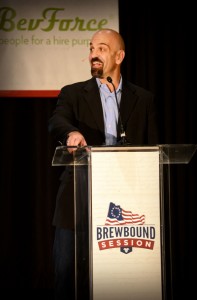
As craft brewers continue chipping away at a U.S. beer landscape primarily dominated by two international mega-brewers, a few rapidly expanding craft beer companies are beginning to consider national distribution models.
But building out that national footprint isn’t as simple as just flipping a switch. There are numerous distributor choices and plenty of necessary considerations, including additional capacity construction, product consistency, organized and dedicated sales forces.
Craft brands hoping to turn their regional success into mainstream acceptability heard from Andy Thomas, the president of commercial operations for Craft Brew Alliance (CBA) — which markets the Widmer Brothers, Redhook Brewery, Kona Brewing, Omission Beer and Square Mile Cider brands — at last week’s Brewbound Session in Boston. Thomas provided attendees with a glimpse of the CBA’s approach to a national profile and offered strategies for smaller brands looking to expand their own distribution territories.
“If you are going to be national, I think it is important to understand that ‘national’ means ‘national,’” he said.
Examples of truly national craft breweries are hard to find; CBA, with its portfolio of distinct offerings, is one of the few that approaches its business with a nationwide network of Anheuser-Busch wholesalers in mind.
Thomas broke down CBA’s approach to being national into two relatively straightforward categories: the ‘hard stuff’ and the ‘soft stuff.’
“It has to start with a point of view,” he said. “You have to have a perspective on what you think is happening in the market.”
That perspective — in Thomas’ eyes — includes having a clear vision on how to seize opportunities, understanding what it will take to realize that vision and recognizing a ‘trueness’ to brands and their capabilities.
That’s the hard stuff.
For Thomas, the soft stuff includes having conviction, a ‘thick skin,’ passion and ‘a healthy dose of patience balanced with a sense of urgency.’
So how does CBA execute their national distribution strategy? As Thomas alluded to, it begins with having a vision. For CBA that vision is one where the consumer mindset and an occasion intersect to create a selling opportunity. Citing data from Yankelovich and Synovate, Thomas explained how today’s consumer shifts between beer, wine and spirits 92 percent of the time.
“Gone are the days of brand loyalty as we knew it,” he said. “Gone are the days where someone was just a beer guy. They don’t exist anymore.”
That’s why CBA has a broad portfolio,Thomas explained, and that different brands aim for different segments of the beer category.
“We unapologetically go after that volume, that occasion, that drinker and that mindset that is typically import, with Kona,” he said. “The mainstream domestic drinker; that is who we go after with Redhook, unapologetically. It is a crossover beer.”
Thomas also explained how the Widmer Brothers brand is designed to appeal to the hardcore craft drinker and how the Omission brand is targeting gluten-sensitive purchasers.

While CBA boasts five complementary brands that, in theory, each compete for a different consumer mindset and occasion, Thomas doesn’t believe that all craft breweries need to take the same approach.
“I think you need to pick your battles,” he said. “Pick what you want to stand for and do that. Find ways to reach that consumer in that occasion.”
Thomas encouraged attendees not to fear the road less traveled when establishing an identity.
“You aren’t going to be able to look to a lot of folks for advice, because they haven’t done it,” he said. “They haven’t had the testicular fortitude to do what you are trying to do.”
He spoke rather bluntly about the need for craft brewers to focus greater attention on distributor relationships.
“I would submit to all of you that it is about time craft put its ‘big boy pants on’ with respect to wholesaler relations,” Thomas said. “It is not enough to just call wholesalers our partners; we need to treat wholesalers like our partners. That requires a different set of skills than a lot of folks have had in the craft industry.”
During his crash course on wholesaler development, Thomas also took time to weigh in on talk of a potential retreat due to irrational exuberance.
“As I look out, I say what bubble and where,” he said of craft’s impressive growth trends. “The dot-com bubble was not caused because the Internet was a fad.”
The driving forces behind the dot-com bubble of the early 2000s were bad decisions, lack of talent and lack of experience, Thomas said. And although he’s optimistic about the future success of the craft category, he expressed his concern that those same very same forces could, if left unaddressed, stymie craft’s impressive growth in recent years.